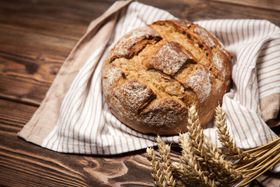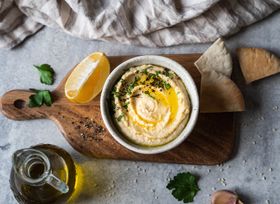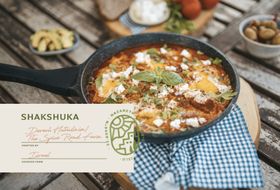Exploring the Flavors of Israeli Cuisine: The Delights of Falafel
Discover the Origins and Variations of Israeli Falafel: A Mouthwatering Delight in Culinary Exploration
Published April 28, 2025

Step into the remarkable world of Israeli cuisine, where a land brimming with cultural richness invites you on an extraordinary culinary journey. Prepare to be immersed in a vibrant tapestry of flavours, spices, and cooking techniques that intertwine with the diverse histories, traditions, and cultures of this extraordinary region.
Israeli cuisine is a delightful mosaic of culinary influences from various regions and historical backgrounds. It weaves together the vibrant flavours of the Middle East, the Mediterranean, North Africa, and beyond, creating a truly unique and unforgettable experience for food lovers.
As a melting pot of cultures, Israel boasts an astonishing range of culinary delights. From the fast-paced markets of Jerusalem to the coastal cities of Tel Aviv and the charming villages of Galilee, every corner of the country offers its own delectable specialities and culinary traditions. Exploring Israeli cuisine is like embarking on a captivating gastronomic adventure, where each bite tells a story of the people, the land, and the history.
In this blog, we delve deep into the heart of Israeli cuisine, uncovering its hidden treasures and shedding light on one of its most beloved dishes: falafel.
Falafel: Considered a culinary icon, falafel has captured the hearts and palates of locals and travellers alike.
Top Israeli cuisines:
Another one of the iconic dishes that comes to mind when discussing Israeli cuisine is falafel.
Falafel has gained international fame for its crispy outside, and tender on the inside; these deep-fried balls or patties are made from a harmonious blend of ground chickpeas or fava beans, fragrant herbs, aromatic spices, and a touch of culinary magic.
These deep-fried balls or patties are traditionally made from ground chickpeas or fava beans mixed with herbs, spices, pickles and onions. The mixture is then shaped into falafel balls or falafel patties and deep-fried until crispy and/or golden brown, depending on preference.
Falafel has become synonymous with popular Israeli street food and is loved by locals and visitors alike. It is renowned for its versatility and is enjoyed as a quick snack, a filling meal, or even as a component of a larger spread of Israeli dishes.
While the classic falafel is made with chickpeas, different regions and cultures have their variations. Some use fava beans instead of chickpeas, while others incorporate additional ingredients like herbs, spices, or even vegetables. The accompanying sauces and toppings can also vary, ranging from tahini and hummus to garlic sauce, pickles, and salads.
Ingredients to make falafel:
Simple and accessible Ingredients: Falafel ingredients are readily available and affordable. Chickpeas or fava beans, herbs, spices, and onions form the base of the mixture. This simplicity contributes to falafel's popularity, as it can be prepared at home or found at numerous street food stalls and restaurants across Israel.
Where did falafel originate from?
Historical Influence: Falafel's origins are believed to originate in Egypt or the Levant region. Over time, falafel has become popular throughout the Middle East, including Israel, where it has been embraced and incorporated into local cuisine.
The history of falafel
The history of falafel spans millennia, deeply rooted in the Middle East. The word "falafel" may have originated from the Arabic term "falāfil," derived from the word "filfil," meaning "pepper." Throughout the region, legume fritters have been enjoyed for countless generations, with variations incorporating fava beans and lentils alongside traditional chickpeas. This original Middle Eastern delicacy has stood the test of time, captivating taste buds and weaving itself into the culinary tapestry of the region.
How to make Israeli-style falafel:
1 cup dried chickpeas, refrigerated overnight in water to cover by 2 inches, then drained, or 1 cup canned chickpeas, drained
1 small onion, diced (about 1/2 cup)
2 cloves garlic, peeled and smashed
2 tablespoons fresh parsley, finely chopped
1 teaspoon ground cumin
1 teaspoon ground coriander
1 teaspoon salt
1/2 teaspoon dried red pepper flakes
1/2 teaspoon baking soda
About 6 cups vegetable oil for frying
Step 2
In a food processor, combine chickpeas, onion, garlic, parsley, cumin, coriander, salt, red pepper flakes, and baking soda. Pulse just until finely chopped and crumbly.
Step 3
In a large shallow skillet over moderately high heat, heat 3 inches of oil until the thermometer registers 350°F.
Step 4
Using 2 teaspoons or a falafel scoop, form the mixture into approximately 1-inch-diameter balls or disks. Working in batches of 5, lower carefully into hot oil and fry, turning occasionally, until deep golden brown, about 1 to 2 minutes. Drain on paper towels. Repeat to fry the remaining falafel, returning oil to 350°F between each batch.
Is falafel healthy?
Falafel, a traditional Middle Eastern dish, can be healthy when prepared right. Made from chickpeas or fava beans, it's a vegan protein source, low in fat, and cholesterol-free when fried in heart-healthy oil. It provides fibre and essential vitamins packed with nutrient-rich ingredients like herbs, spices, and vegetables. Customizable and versatile, enjoy falafel in a whole wheat pita with fresh veggies for a well-rounded and nourishing meal.
Discover the culinary wonders of Israel like never before with Artza! Indulge in tantalizing Artza recipes meticulously crafted by top chefs in Israel, using locally sourced ingredients that capture the essence of the Holy Land. Join the ever-growing Artza community of over 100,000 members and unlock the magic of our faith subscription box. Prepare to be amazed every three months as a treasure trove of delights arrives at your doorstep. Discover exotic Israeli spices, mouthwatering recipes, captivating crafts, extraordinary gifts, awe-inspiring art, and so much more. Don't miss out on this extraordinary journey. Click here to embark on an adventure of flavours, culture, and faith with Artza today!







